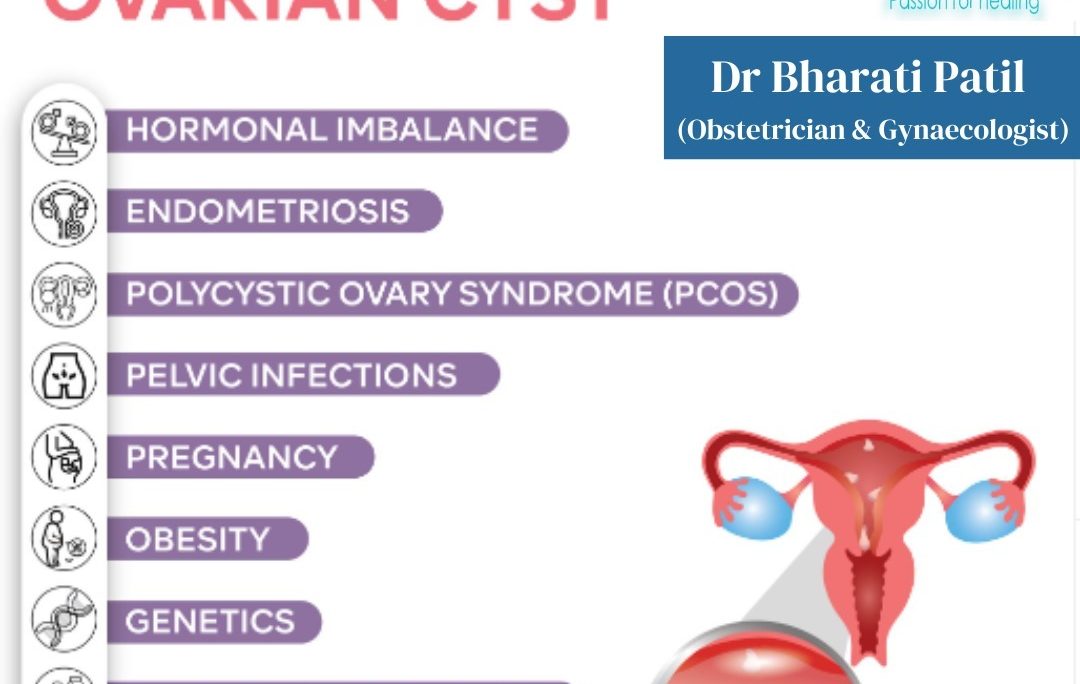Ovarian cysts are a common gynecological condition that affects women of all ages. These fluid-filled sacs form on or within the ovaries and are often harmless, resolving on their own without causing any symptoms. However, in some cases, ovarian cysts can grow larger, cause discomfort, or even lead to complications. Understanding the causes of ovarian cysts is essential for identifying risk factors and ensuring early diagnosis and proper treatment. In this blog, we will explore the various causes of ovarian cysts, their types, and factors that increase the likelihood of developing them.
What Are Ovarian Cysts?
Ovarian cysts are small, fluid-filled sacs that can develop on one or both ovaries. These cysts can vary in size and type, and while most are benign (non-cancerous), they can sometimes cause pain or other complications. Ovarian cysts are particularly common in women of reproductive age, but they can also occur in postmenopausal women.
Causes of Ovarian Cysts
The causes of ovarian cysts can vary depending on the type of cyst. Most cysts are considered “functional,” meaning they form as part of the natural menstrual cycle and usually go away on their own. However, other types of cysts can be linked to underlying health conditions or hormonal imbalances. Below are the primary causes of ovarian cysts:
- Hormonal Imbalances
Hormonal imbalances are one of the most common causes of ovarian cysts, particularly functional cysts. Functional cysts are linked to the normal functioning of a woman’s reproductive system and are divided into two main types:
Follicular Cysts: During the menstrual cycle, a follicle in the ovary grows to release an egg during ovulation. If the follicle does not rupture and release the egg, it continues to grow and forms a follicular cyst. These cysts usually resolve on their own within a few menstrual cycles.
Corpus Luteum Cysts: After the follicle releases the egg, it becomes the corpus luteum, which produces hormones to support pregnancy. If pregnancy does not occur, the corpus luteum typically dissolves. However, in some cases, it fills with fluid, forming a corpus luteum cyst. These cysts are usually harmless but may cause pain or discomfort.
Hormonal imbalances, such as those seen in conditions like polycystic ovary syndrome (PCOS) or hypothyroidism, can increase the risk of developing functional cysts.
- Polycystic Ovary Syndrome (PCOS)
PCOS is a hormonal disorder that affects many women of reproductive age. Women with PCOS often have multiple small cysts in their ovaries, leading to enlarged ovaries and a range of symptoms, including irregular periods, infertility, weight gain, and excess facial hair. PCOS-related cysts develop because the ovaries fail to release eggs regularly, causing them to accumulate in the follicles, forming multiple cysts.
PCOS is associated with an imbalance in reproductive hormones, including increased levels of androgens (male hormones) and insulin resistance. The exact cause of PCOS is not fully understood, but it is believed to involve a combination of genetic and environmental factors.
- Endometriosis
Endometriosis is a condition where tissue similar to the lining of the uterus (endometrium) grows outside the uterus, often on the ovaries, fallopian tubes, and other pelvic organs. This misplaced tissue can cause the formation of ovarian cysts called endometriomas. Endometriomas, also known as “chocolate cysts,” are filled with thick, dark fluid and can cause severe pain, especially during menstruation or intercourse.
Women with endometriosis are more likely to develop ovarian cysts due to the persistent growth of endometrial tissue on the ovaries. These cysts may require medical treatment or surgical removal, depending on their size and the severity of symptoms.
- Pregnancy
Ovarian cysts can also develop during pregnancy, particularly in the early stages. In some cases, a corpus luteum cyst forms to help support the pregnancy by producing hormones. This type of cyst typically goes away by the second trimester as the placenta takes over hormone production. However, if the cyst persists or grows larger, it may cause complications and require monitoring or treatment. - Severe Pelvic Infections
Severe pelvic infections, such as pelvic inflammatory disease (PID), can spread to the ovaries and fallopian tubes, leading to the formation of ovarian cysts. Infections caused by sexually transmitted diseases (STDs) or other bacterial infections can result in abscesses or cysts that may need antibiotic treatment or drainage.
Pelvic infections can cause inflammation and scarring in the reproductive organs, increasing the risk of developing cysts. Women with a history of PID or untreated STDs should seek medical attention to prevent complications related to ovarian cysts.
- Cystadenomas
Cystadenomas are non-cancerous growths that develop on the outer surface of the ovary. These cysts are filled with a watery or mucous-like substance and can grow to a large size, causing discomfort or pressure in the abdomen. Unlike functional cysts, cystadenomas are not related to the menstrual cycle and may require surgical removal if they become large or symptomatic. - Genetic Factors
Genetic factors may also play a role in the development of ovarian cysts. Women with a family history of ovarian cysts, PCOS, or endometriosis may be at higher risk of developing cysts themselves. Inherited conditions such as BRCA1 and BRCA2 gene mutations, which are linked to an increased risk of ovarian and breast cancer, can also increase the likelihood of developing ovarian cysts, though these cysts may require more careful monitoring.
Conclusion
Ovarian cysts are a common condition among women, and while many cysts are harmless and resolve on their own, understanding their causes is essential for proper diagnosis and management. Hormonal imbalances, conditions like PCOS and endometriosis, pregnancy, and infections are among the leading causes of ovarian cysts. While most cysts are benign, some may cause pain, discomfort, or complications, making it important to monitor symptoms and seek medical advice when necessary.
Regular gynecological check-ups and pelvic exams can help detect ovarian cysts early, ensuring timely treatment and reducing the risk of complications. If you experience symptoms such as pelvic pain, bloating, or irregular periods, consult your healthcare provider for a thorough evaluation and personalized care.
For Consultation Contact us on 9168690447
Website – www.chetnahospital.co.in
Address – Chetna Hospital, Sambhajinagar, MIDC, G Block, Near Rotary Club, Chinchwad 411019













